Croatia Logs 175 New COVID Cases, Four Deaths
ZAGREB, 23 June 2022 - Croatia has registered 175 new COVID-19 cases and four related deaths in the last 24 hours, the national COVID-19 crisis management team reported on Thursday.
Currently, there are 2,770 active cases, and 210 patients in hospital treatment, including five patients on ventilators.
Since 25 February 2020, when the first infection with the novel SARS-CoV-2 virus was confirmed in the country, COVID-19 has claimed 16,043 lives in Croatia.
As of 22 June 2022, 59.54% of the total population or 70.81% of the adult population has been vaccinated.
For all you need to know about coronavirus specific to Croatia, make sure to bookmark our dedicated section and select your preferred language if it isn't English.
Four-Time Oscar Winner Joel Coen Opens 2nd Ponta Lopud Film Festival
ZAGREB, 23 June 2022 - The second edition of the Ponta Lopud Film Festival opened on the beach of the Hotel Lafodia on the island of Lopud, off Dubrovnik, on Wednesday evening with the screening of the Coen brothers' film Fargo.
The opening ceremony was attended by four-time American Academy Award winner Joel Coen, who has been making award-winning films with his brother Ethan for four decades.
Mr Coen said it is inspiring to see that the festival is built around a young generation of filmmakers. He will be holding a masterclass workshop for young talent from Croatia and the region and will be joined by four-time Oscar winning actress and producer Frances McDormand.
The festival's co-founder Mirsad Purivatra said that Ponta Lopud is a creative hub and place where people from the film industry meet and inspire each other, and watch and discuss films.
"This is not a competitive festival. This is about creativity, friendship and networking," Purivatra said.
In addition to Coen and McDormand, masterclass workshops will also be held by award-winning film producer Peter Spears, film agent Brian Swardstrom, and director and writer Juho Kuosmanen.
Over the six days, the festival will show eight evening film screenings and seven films in the Franciscan Monastery and the beach of the Hotel Lafodia.
For more, check out our lifestyle section.
Milanović Seeks EU Membership Candidate Status For Bosnia And Herzegovina
ZAGREB, 23 June 2022- Croatian President Zoran Milanović on Thursday again urged the European Union to grant membership candidate status to Bosnia and Herzegovina.
EU leaders are meeting in Brussels on Thursday for a two-day summit to decide on the membership candidate status for Ukraine and Moldova, for which there is widespread support.
Milanović on Thursday requested the same status for Bosnia and Herzegovina. He has Slovenian President Borut Pahor's strong support for this, and Austria has also joined the initiative.
"We have heard from all member states that Ukraine will get the candidate status, which is fine, but Ukraine, just like Moldova, has some huge problems," Milanović said.
"This is an opportunity to grant Bosnia and Herzegovina the candidate status, as an act of confidence and hope," the Croatian president said, adding that he could not see how anyone could be against it.
For more, check out our politics section.
Germany Wants Western Balkans To Be Given Realistic Opportunity For EU Membership
ZAGREB, 23 June 2022- Germany wants the Western Balkan countries to be given a realistic opportunity to join the European Union, Chancellor Olaf Scholz told the press in Brussels on Thursday ahead of a meeting of EU and Western Balkan leaders.
"The citizens in the Western Balkans have been waiting for almost 20 years for the opportunity to become members of the European Union. It is of utmost importance that this becomes a credible promise because the many efforts that these countries have undertaken must in the end actually lead to their admission," Scholz said.
The EU leaders are meeting their Western Balkan counterparts before their regular summit, which is expected to adopt a historic decision to grant membership candidate status to Ukraine and Moldova.
The EU leaders are expected to again express their full and unequivocal commitment to membership prospects for the Western Balkan countries and call on them to speed up the accession process.
Three EU member states have asked that Bosnia and Herzegovina also be granted candidate status, but there is no consensus on the matter, according to a high-level EU official knowledgeable about the preparation of the summit.
Croatia supports membership candidate status for Bosnia and Herzegovina and demands that the country's electoral law be amended to ensure equality for the Croats as the least numerous of the three constituent peoples.
One of the toughest issues facing the summit is efforts to remove Bulgaria's blockade of the opening of accession talks with North Macedonia. The Bulgarian government received a vote of no confidence on Wednesday, and there are indications that Sofia is willing to remove the blockade based on a French proposal. However, the question is whether North Macedonia will agree to it.
The French EU presidency has proposed a negotiating framework for North Macedonia that includes some of the Bulgarian demands.
Bulgaria has set as a condition for the removal of the blockade that the negotiating framework include issues relating to the common history, language and national identity of Bulgaria and North Macedonia.
Edi Rama, the Prime Minister of Albania, which is included in the same package as North Macedonia, said that it was a shame that NATO member Bulgaria should block two other NATO members, Albania and North Macedonia, in the middle of "a hot war in Europe's backyard" as 26 other EU member states displayed "frightening impotence".
Serbian President Aleksandar Vučić commented on Croatia's remarks that Serbia could no longer sit in two chairs at the same time.
"Serbia is sitting in its own chair, and it is not the Croatian prime minister and president who will lead Serbian politics, but the citizens of Serbia through their leadership," Vučić said.
For more, check out our politics section.
Second of Five Meteorological-Oceanographic Buoys Set up Near Palagruza
June the 23rd, 2022 - The second of a planned five meteorological-oceanographic buoys have has been set up near Palagruza as part of a much wider strategic Croatian project in the field of meteorology.
As Morski writes, last week, Plovput completed the installation of the second of five meteorological-oceanographic buoys at the pre-planned Palagruza site. The Palagruza buoy was anchored to a depth of 190 metres and the anchoring was done with two-part concrete blocks with a total weight of 30 tonnes.
The process surrounding the anchoring was performed using unique technology consisting of the controlled laying of the anchor blocks, developed within Plovput for the needs of this and all future similar projects.
The Palagruza buoy installation project is a strategic project of the Republic of Croatia in the field of meteorology, and is being implemented by the State Hydro-Meteorological Institute. They will provide very high-quality, reliable and timely data on the state of the atmosphere and the sea across the entire territory of the Republic of Croatia (www.meteo.hr).
All of the above represents a historic moment for the meteorology and oceanography of the Republic of Croatia and is an undoubted contribution to raising the level of navigation safety in the territorial sea of the Republic of Croatia on the whole.
For more, make sure to check out our dedicated lifestyle section.
Novska Video Game Summer Camp on Offer to Children This Season
June the 23rd, 2022 - During the very height of this summer season, a brand new Novska video game summer camp will be on offer to children of all ages interested in getting better acquainted with this sort of technology which has put Novska firmly on the map.
As Poslovni Dnevnik/Josipa Ban writes, this summer, elementary school students will also be able to get to better acquainted with the interesting world of video game making, thanks to the Pismo Business Incubator and their Novska video game summer camp for kids.
Over a period of two terms during the school summer holidays, students of the upper grades of primary schools will be able to learn to make their own video games during their seven days spent at the camp.
"We're aware of the fact that children spend most of their time in front of a computer playing video games during the summer holidays, so we decided to organise a camp and allow them to spend time in front of the screen learning to produce video games,'' the organisers explained.
The youngest children will be able to acquire new technological knowledge through two terms, from July the 3rd to the 7th, and then from August the 21st to the 28th. Additionally, for elementary school students who decide to take an active, educational holiday, the day will be filled with various activities.
“They will get acquainted with the top technologies boasted by the the Pismo Incubator, in the Social Innovation Incubator they will learn to record, edit and stream content, and in the stem workshops they'll be able to learn about microbits and robotics.
They will also ''programme'' nature, but without computers and mobile phones in the Dupin scout camp, and time is left for a full day trip to the Lonjsko polje Nature Park,'' announced Ivana Matanovic.
Ivan Celjak, Sisak-Moslavina County's prefect, pointed out that the gaming industry brings economic progress to the whole society. “That's why we're pleased with the number of 28 percent more newly opened companies in our county in 2021. Some of these 319 start-ups are gaming companies and that's why it's important to educate children from an early age. We're glad that in addition to more than 200 adults who were educated within Pismo, small game developers now have the opportunity to learn,'' pointed out Celjak when discussing the Novska video game summer camp.
For more, make sure to check out our dedicated lifestyle section.
Eight Must-Visit Croatian Castles, Fortress, and Citadels
June 23, 2022 - In this small guide to Croatian castles, fortresses, and citadels you will find some of the many walled wonders that you can explore in the country, to add a bit of history to your vacation.
It is well known why Croatia is one of the countries where HBO producers set their sights on adapting the acclaimed and popular Game of Thrones novel. Although Croatia is widely known for its Illyrian and Roman heritage thanks to its palaces and amphitheater, many of its castles and fortresses help to display a more medieval side of the country.
For those who have a particular interest in the feudal and medieval history of Croatia, here we review some of the main Croatian castles, fortresses, and citadels that are worth visiting.
Pula Castle
The Pula Castle is a star-shaped castle with four bastions that was built in 1630 to protect the city and its harbor because of its great significance in maritime trade in the North Adriatic. The Venetians commissioned the building of the Castle to the French military architect Antoine de Ville. This was most probably the site of an earlier fortress dating from the pre-Roman and Roman periods. Today the Castle houses the Historical Museum of Istria.
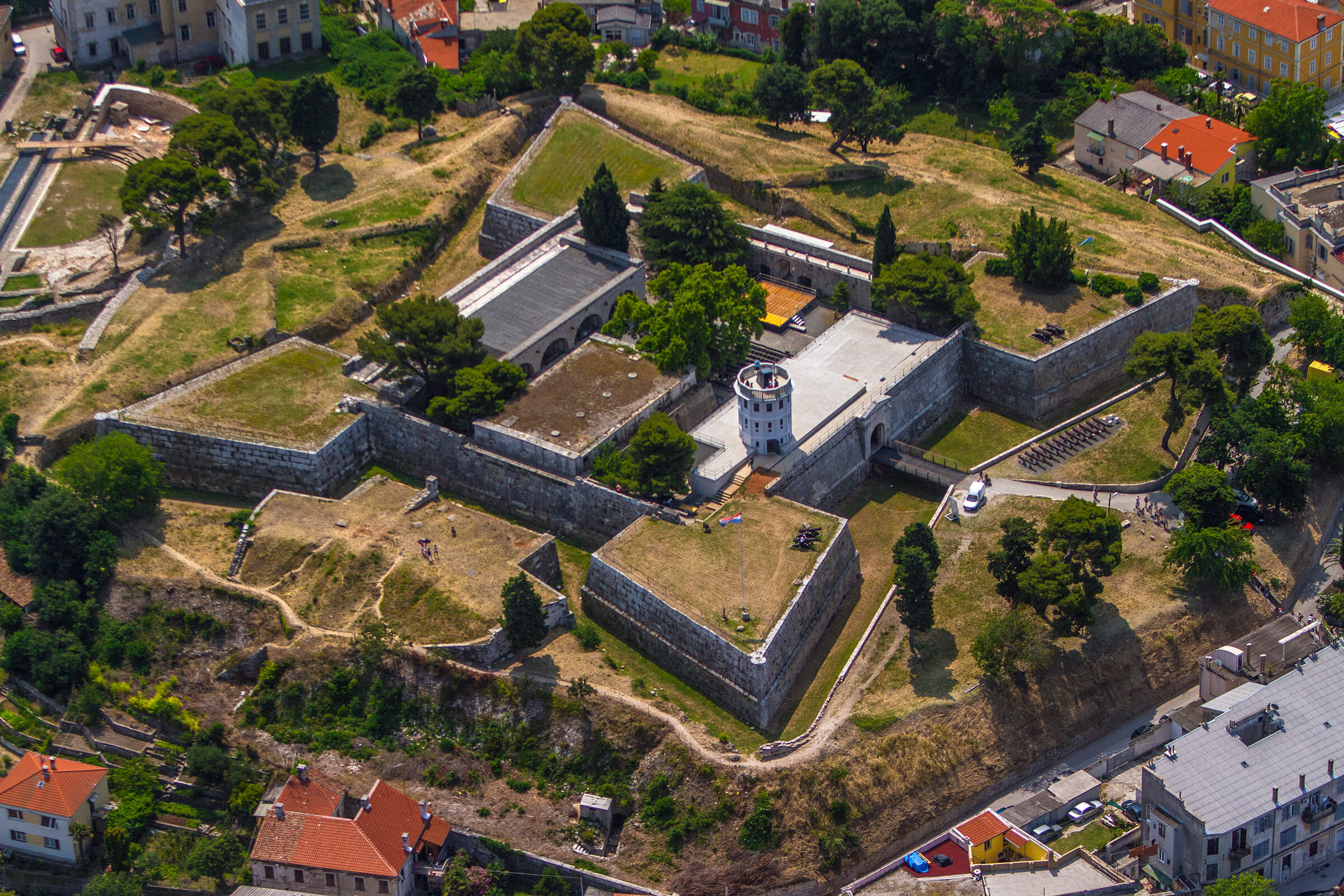
Image: Pula Tourist Board
Trsat Castle
The Trsat Castle served as a lookout on a hill 138 meters above sea level, now overlooking the city of Rijeka. It was mentioned as a parochial center for the first time in 1288. At this same site, there was a Liburnian observation post from prehistoric times, used for monitoring the roads leading from the hinterland to the coast. This location served well for the Romans to establish their defense system, the so-called Liburnian limes, whose starting point was the Tarsatica fortress town, located now in Rijeka's Old Town.
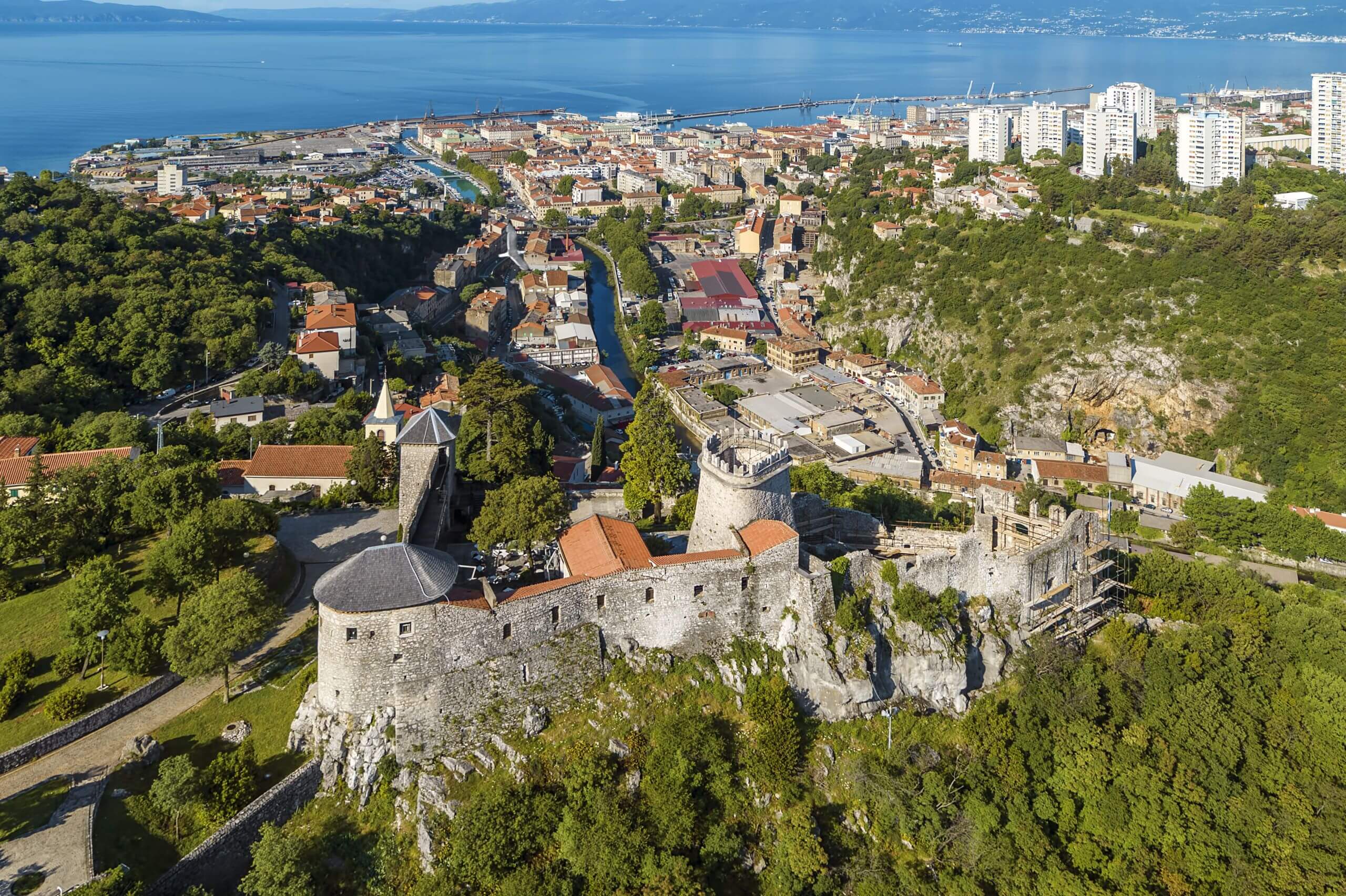
Image: Rijeka Tourist Board
Dubovac Castle in Karlovac
The Dubovac castle is one of the best-preserved and most beautiful monuments of feudal architecture in Croatia. It was built on a hill above the Kupa river and was named after an oak that grows on the surrounding slopes. It changed owners throughout history, changing its appearance depending on current needs and fashion, and got its present appearance after a complete reconstruction in the mid-20th century. It is not known exactly when did construction begin, but books say that it was finished during the 13th century.

Image: Karlovac Tourist Board
Trakošćan Castle
The Trakošćan castle was built at the end of the 13th century in the defense system of northwestern Croatia as a small observation post to monitor the road from Ptuj to the Bednjan valley. According to the legends, the Trakošćan castle got its name from the Thracian fortress, which allegedly existed in ancient times. Another surviving tradition says that it was named after the Drachenstein knights who ruled the area in the early Middle Ages. A museum with a permanent exhibition was founded in 1954.
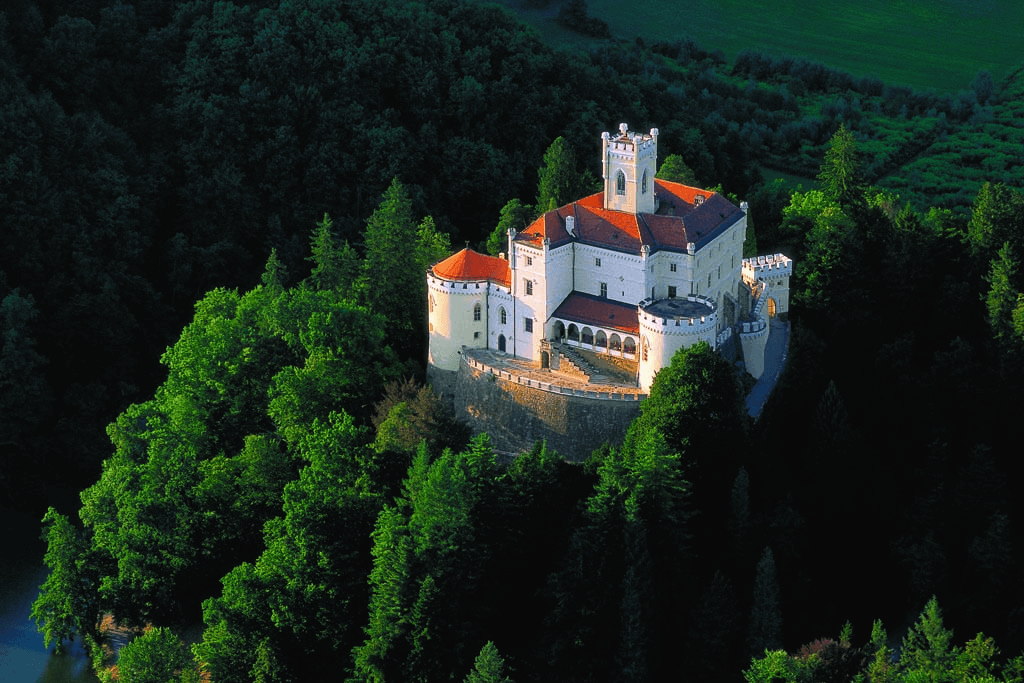
Image: Trakošćan
Varaždin's Old Town
Varaždin’s feudal fortress, known from ancient times as the Old Town, is undoubtedly the most significant historical building in the city. Unlike the royal free city that grew next to and around it, the fort was the heart of the noble estate, which was separate in terms of ownership and law. Disputes between its inhabitants with the citizens of Varaždin were frequent. The fort was built intermittently from the 14th to the 19th century, and its oldest part is the central tower adorned with Gothic benches and canopies, which is a rarity for this type of medieval plastic art in north Croatia.

Photo: Mario Romulić
Medvedgrad in Zagreb
At the top of Medvednica, this picturesque medieval castle has been watching over Zagreb for eight centuries. It was built in 1254, after the catastrophic invasion of Tatars who had raided and devastated this area, burning and razing to the ground the two settlements which later became the city of Zagreb: the burgher’s Gradec and the bishop’s Kaptol. Even though magnificently fortified and always ready for battle, Medvedgrad was never attacked. In 2021, Medvedgrad was reopened to the public with a modern and interactive museum inside.
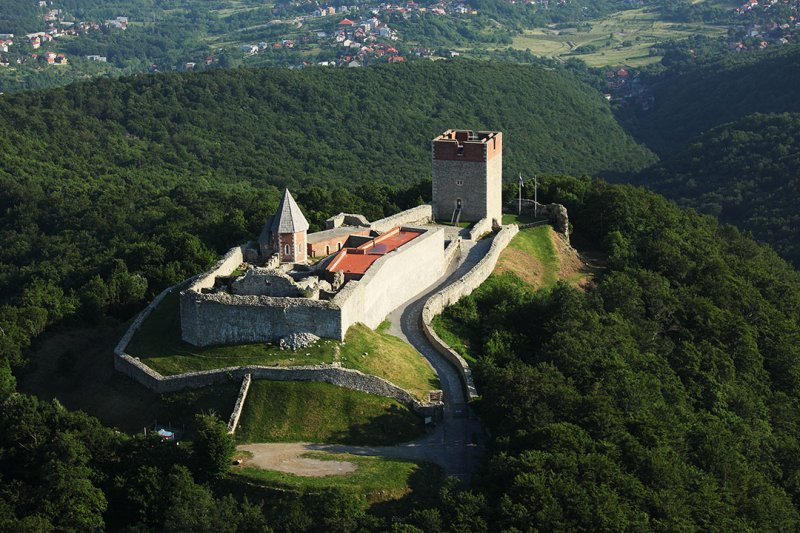
Image: Zagreb Tourist Board
St. Nicholas Fortress in Šibenik
The fortress of St. Nicholas, located at the entrance to the Channel of St. Ante in Šibenik, is a unique Venetian fortification. It was built on the island of Ljuljevac, on the site of the former Benedictine monastery of St. Nicholas, after whom it was named. The construction of the fortress, according to the project of the Venetian architect Gian Girolamo Sanmichelli, began in 1540 after the fall of the city of Skradin under Ottoman rule, when the Venetians had to strengthen the defense of Šibenik, its most important strategic port on the eastern Adriatic coast.

Image: Šibenik Tourist Board
Klis Fortress
Klis fortress was built on an extraordinary strategic location separating the mountains of Mosor and Kozjak that allowed military and commercial control over the whole Klis valley and the area of Salona and Split. Because of its importance, Klis was often referred to as the key to Dalmatia and the heart of the medieval Croatian kingdom. It was built as a small stronghold by the Illyrian tribe Dalmatae, then became a royal castle during feudal and medieval times, and lastly served as a major source of defense against the Ottoman advance.
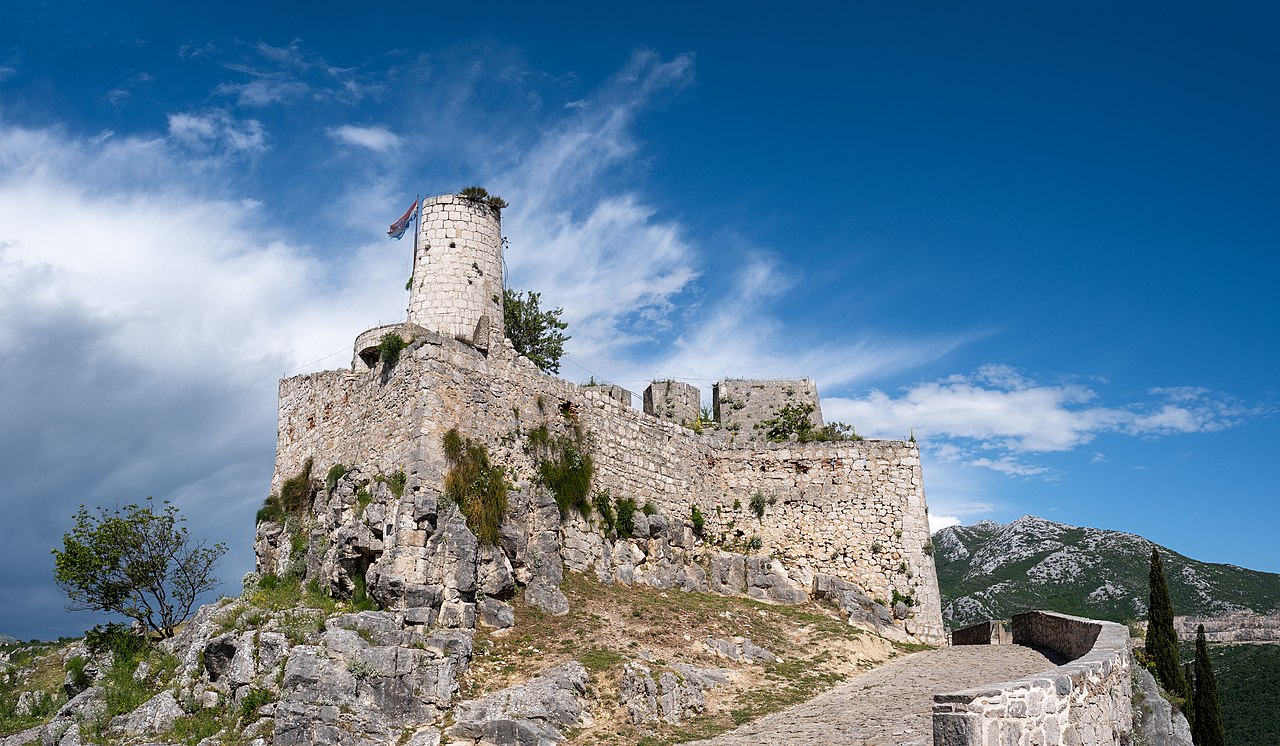
Image: Jules Verne Times Two/Wikimedia Commons
For more on travel in Croatia, follow TCN's dedicated page.
Zagreb Wild Boars Attack Dog, Hunters Agree to Meeting
June the 23rd, 2022 - It might not really be what one would really expect in a bustling capital city, but Zagreb wild boars which live in the surrounding hills have been getting closer and closer to the centre, and have now attacked a dog.
As Poslovni Dnevnik writes, a reader of Index sent a disturbing video of a dog who had been sadly attacked by Zagreb wild boars and warned that the feral pigs were seen again between Mikulici and Bijenik. He stated that they also attacked a dachshund in some neglected cherry orchards. He also added that there are a lot of people walking dogs and letting them off their leads, which could lead to accidents happening. The disturbing video showed the extent of the injuries the dog suffered as a result of the violent attack.
Groups of Zagreb wild boars are getting braver when it comes to where they roam and are getting closer and closer to the city centre. ''A whole bunch of them walked across the road near the traffic lights. I'm afraid to leave the house because I don't know where I could come across a feral pig in the dark,'' said Djurdja Djuranec for Dnevnik Nova TV. That said, the problem isn't only fear, but also the fact that pigs destroy everything they come across, from flowers to fruit and vegetables, as well as the eggs of ground nesting birds.
Boar hunters are seeking an urgent meeting with Mayor Tomasevic
The number of calls to the Croatian Hunting Association has only increased. On a daily basis, people are calling them and reporting having seen wild boar wandering around. That's why the Alliance is asking for an urgent meeting with Zagreb Mayor Tomasevic to discuss the matter and how to handle it.
The president of the Croatian Hunting Association, Ivica Budor, says that they are asking for a meeting "so that we don't find ourselves in a situation where we have to explain why wild boars are walking along Medvednica, Mikulici and Maksimir today, and maybe tomorrow we'll be seeing them wandering around Zrinjevac". Who will be to blame then? asked Budor, who believes it's only a matter of time before these troublesome Zagreb wild boars reach the heart of the city centre. He believes there are wild boar litters in the city already.
City of Zagreb: We'll gladly receive hunters for a meeting
The City of Zagreb told Dnevnik Nova TV that they would fladly receive representatives of the Croatian Hunting Association for a meeting, adding that a game protection programme had been established and adopted in the urban part of Zagreb and was being successfully implemented.
Zagreb hunters think the exact opposite, that it isn't being implemented at all. Miljenko Kruc from the Hunting Association of the City of Zagreb said that these pigs seem adaptable and that no attack on humans has been recorded. That said, they ARE attacking pets and other animals. They're also carriers of the African swine fever virus to domestic pigs. But so far, according to the Ministry of Agriculture, no case of the disease has been recorded in Croatia.
The City of Zagreb has announced that these Zagreb wild boars that have been spotted in different parts of the city. They explained where they were spotted and what to do if you happen to come across them.
In the urban area of the City of Zagreb, the wild boar is an occasional species of game that migrates daily to easily accessible food and water sources in urban areas, most often in summer-autumn, and in the dry season an additional reason may be access to water sources (Maksimir lakes, Jarun, the banks of the Sava river and various streams).
In this area, Zagreb wild boars, as well as other species of game, are treated in accordance with the Game Protection Programme for the City of Zagreb implemented by the Zagreb Zoo and the Hunting Association of the City of Zagreb.
In order to prevent damage from wildlife, the Wildlife Protection Programme prescribes the following measures: education and cooperation with landowners and users, the procurement of chemical, biological and biotechnical protective equipment and their free distribution to landowners and users at their request, the protection of crops and plantations with the expulsion of wildlife and using protective equipment and scarecrows, etc.
People have been advised that if they notice Zagreb wild boars or other game, they should not approach them and should move away. If they have dogs, they should be kept on their leashes so as to avoid confrontation with these notoriously poor-tempered creatures.
Any information from people who have had run ins with Zagreb wild boars, as well as additional information on handling wildlife and damage from wildlife in urban areas of the City of Zagreb can be given/obtained from the Zagreb Zoo at: 01 / 230-2198 or 091 / 6045-506, email: This email address is being protected from spambots. You need JavaScript enabled to view it. or This email address is being protected from spambots. You need JavaScript enabled to view it..
For more, make sure to check out our dedicated lifestyle section.
Changes to How Croatian Police Fines are Prescribed Coming
June the 23rd, 2022 - Changes to how Croatian police fines are prescribed are afoot, with officers now being trained in how to use POS devices similar to those used in cafes and restaurants to facilitate payment by card.
As Poslovni Dnevnik writes, Croatian police officers are being educated on how to use POS devices, and the cash collection of traffic fines from the beginning of July will no longer be possible, as reported by the Ministry of the Interior (MUP).
From July the 1st, 2022, people will no longer be able to pay cash fines for traffic offenses at the scene of the offense, but from that date, the Ministry of the Interior will switch to cashless collection of fines via POS devices.
For this purpose, the Ministry of the Interior, through the Central State Office for the Development of Digital Society and the Financial Agency, procured 600 POS devices, which are deployed in police departments throughout the Republic of Croatia.
Officers are being trained for this new way of collecting Croatian police fines
The training of police officers on how to use POS devices is underway, and with faster, more efficient and transparent functioning at the scene of the offense, by waiving the payment of fines in cash, the Ministry of the Interior is meeting the recommendations of the Report of the 5th Evaluation Circle of GRECO. This is part of the official body of the Council of Europe which specialises in the prevention of corruption, and which works to improve the control and supervision of the existing system of the payment of fines to police officers, and reduces the risk of corruption among the police officers themselves..
In addition, the aforementioned change includes the recommendations of the Independent Internal Audit Service of the Ministry of the Interior.
"We'd like to emphasise that the police are already using POS devices for the collection of fines out in the field, along with the collection of fines in cash, while from July the 1st, the possibility of paying the fine in cash will no longer exist. A person who, through a POS device, pays a fine at the place where the offense was committed will be handed a Certificate that the fine and the costs of the procedure have been paid, and a slip made upon the transaction performed through the POS device.
What if you don't have your bank card with you?
If person wants to pay their fine at the place of the crime, but is unable to do so because they don't have a card with them, don't have enough funds in their bank account or some other reason, the police officer will hand him a Notice of Misdemeanor. In that case, the fine shall be deemed to have been collected at the place where the misdemeanor was committed if the person in question pays the fine, reduced by half, within three days of receiving the Misdemeanor Notice and submits proof of payment to the body that determined the misdemeanor.
For more, make sure to check out our dedicated lifestyle section.
The Island of Krk: Unmissable Destinations on Croatia's Golden Island
June 23, 2022 - While the Dalmatian islands remain the most popular among tourists, others like the island of Krk deserve your full attention and you don't even know it yet.
Let's try something. Go ahead and think of a Croatian island other than Hvar. Or Brac. Or Korčula. Or Vis. Or Pag. Or Mljet. Or Dugi Otok. Or Lopud. Or Lastovo. Remember, there are more than 1000 islands in Croatia! This is in no way a criticism. These islands are positioned better than any other and for the fairest reasons. The reputation of its beaches, nightlife, traditions, heritage, and more precedes them. The marine traffic in the Dalmatian islands is impressive, and it is understandable. However, some paradises on the northern Adriatic sea have little or nothing to envy the Dalmatian ones.
One of them is the island of Krk, located in the center of the Kvarner Bay and belongs to the Primorje-Gorski Kotar county. Krk has an area of 405.80 km2 and a population of almost 20,000 inhabitants and is the second-largest island in Croatia. Known as the ''Golden Island'', Krk is perhaps the most accessible island in the country. Why? For starters, Krk is connected by a bridge to the mainland, which allows residents and visitors to get around by car and bus very easily. In addition, Rijeka airport is located precisely on the island of Krk, so if you have booked an island accommodation and arrive by international flight, you will not have to worry much about how to get to your destination.
If the island of Krk is your choice as your next travel destination, you will enjoy a place that boasts an enormous history as it is home to the largest heritage of Glagolitic writing in the country, premium wines and olives, one of the most important pilgrimage routes in the world, Camino Krk; as well as being recognized as a health tourism destination, due to its impeccable air.
Although the island of Krk deserves to be recognized as a spectacular whole, in this article we share a little detail about the destinations that you can visit on the island.
Omišalj
Omišalj is a historic town located on the north-western part of the island of Krk and situated at 85 meters above sea level. Omišalj's privileged position seems to have attracted not only modern humans but also prehistoric inhabitants, which explains why Omišalj has existed for more than 10,000 years. Omišalj is one of the oldest towns on the island and today it is an important glagolitic and cultural center. Learn more about Omišalj HERE.
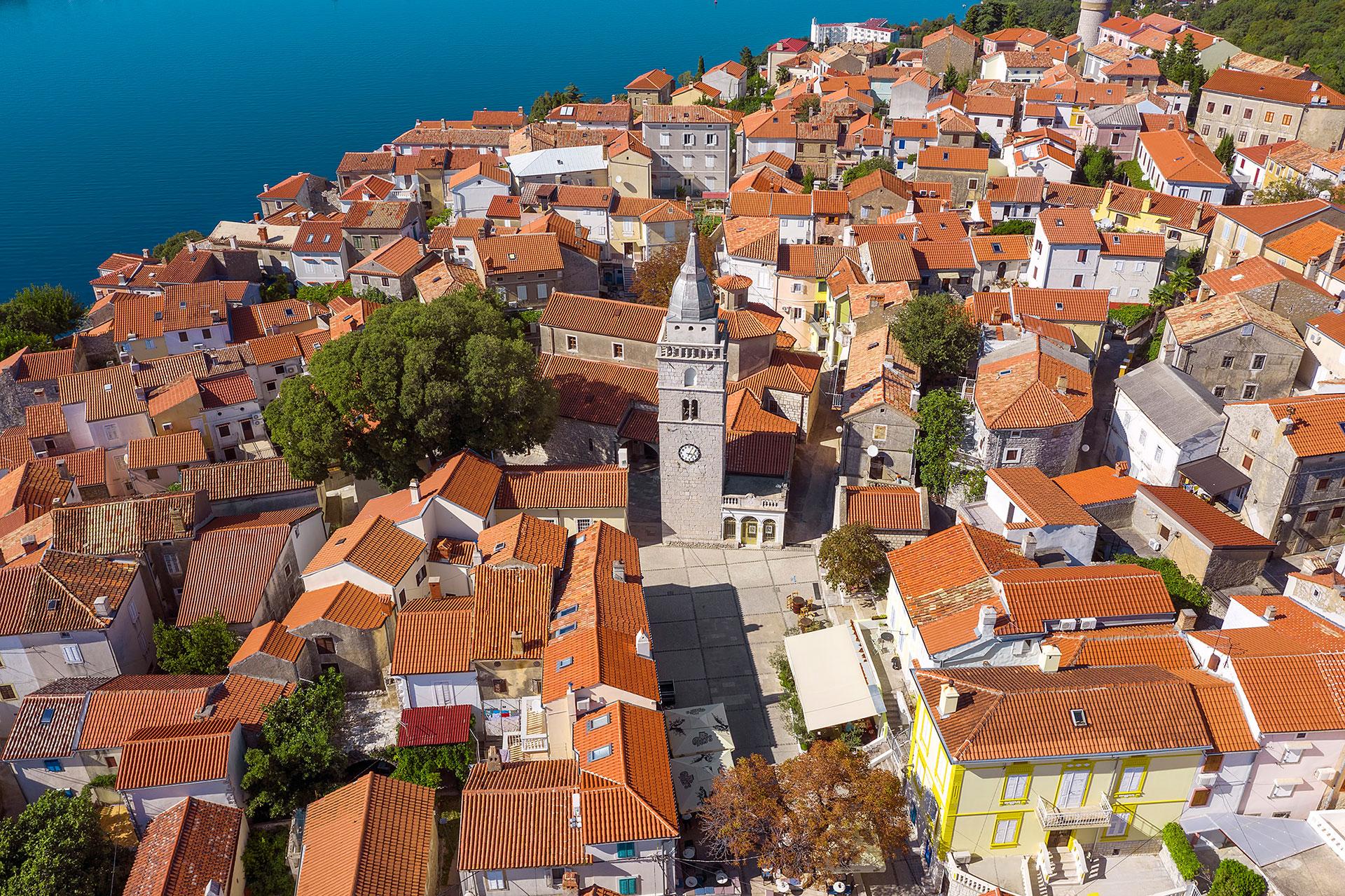
Image: Krk Island Tourist Board
Njivice
Njivice is located very close to Omišalj and belongs to the Municipality of Omišalj. Also with a rich history, Njivice has been inhabited mainly by fishermen, olive groves workers, and cattle-breeders. Njivice has always stood out for its picturesque houses along the shore and the fishermen's boats and nets, creating a typical postcard of the place. Njivice today has modern and high-quality accommodation, including hotels and camping sites. Learn more about Njivice HERE.

Image: Arne Müseler/Wikimedia Commons
Malinska
Malinska is one of the most popular destinations on the island of Krk, and in addition to its excellent beaches and accommodation options, it has an important marine heritage. Malinska, surrounded by forests, was once a timber export port and a favorite destination for the Viennese aristocracy. Due to its position, Malinska was also an anchor point for many ships to protect themselves from strong winds and tides. Today Malinska has a new and modern interpretation center, and the old shipyard is still operating on the same site. Learn more about Malinska HERE.

Image: Arne Müseler/Wikimedia Commons
Krk Town
The town of Krk is the administrative, political, economic, and religious center of the island of Krk. It is the town with the most inhabitants on the island, with a population of approximately 7,000 inhabitants. It is worth mentioning that the town of Krk was mentioned by the famous Greek writer Homer in a poem under the name of Koureto. Undoubtedly, the highlight of Krk is its impressive cathedral complex, built in the 5th century. Learn more about the town of Krk HERE.

Photo: Mario Romulić
Punat
Punat is located on the east coast of the island of Krk and is considered one of its most popular destinations. Despite being considered the most recent town on the island, Punat also boasts a lot of history, culture, and heritage. There you will find not only one of the most modern nautical and marina centers in the entire country, but Punat is also the main olive-growing center on the island. When speaking of Punat, it is always necessary to refer to the small island of Košljun, where a Franciscan monastery is located. Learn more about Punat HERE.
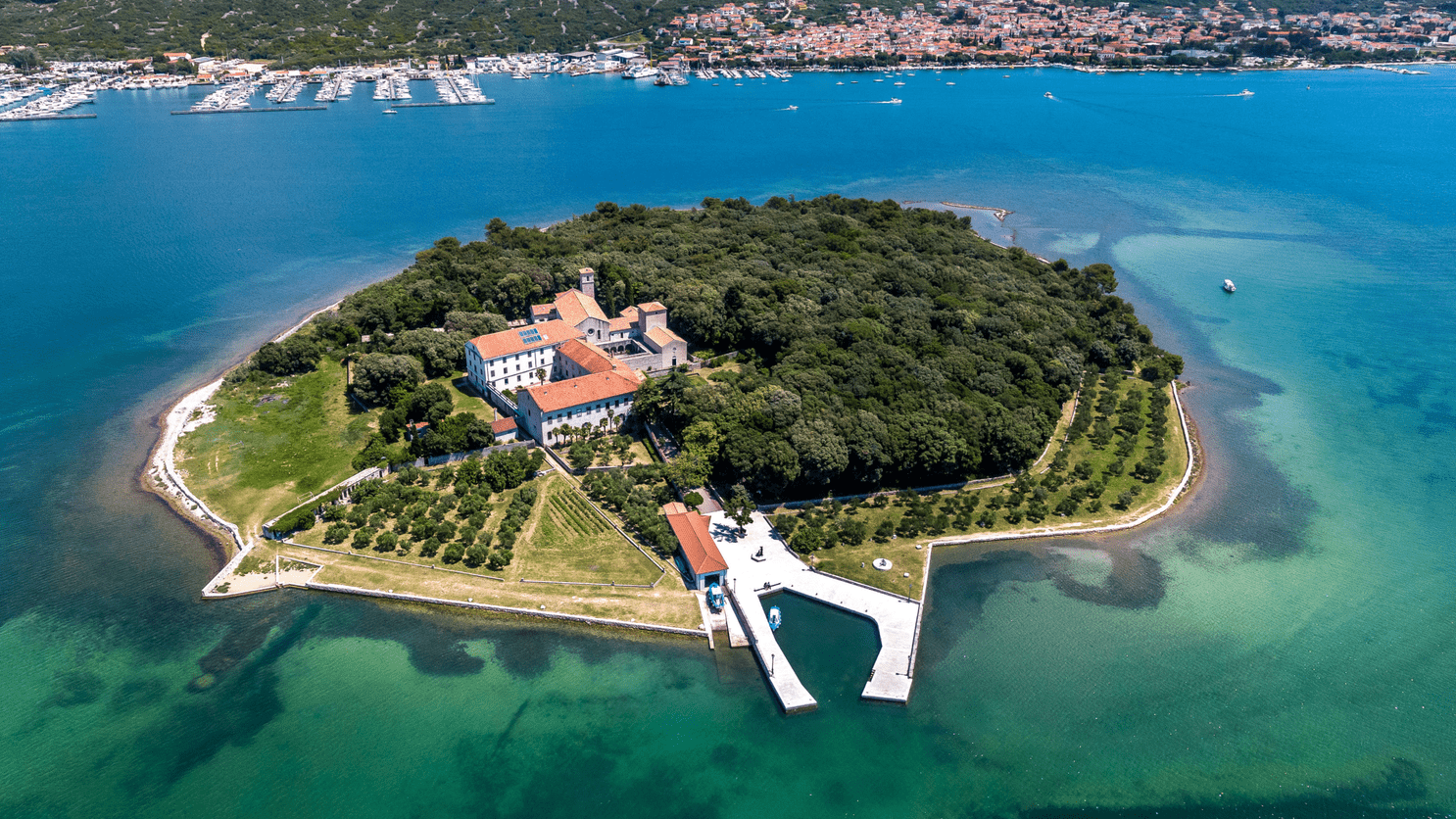
Image: Krk Island Tourist Board
Baška
Baška is located at the southern tip of the island of Krk, and is definitely one of the most prominent destinations. No matter what angle you see it from, the beauty of Baška is undeniable. In addition to its spectacular and extensive beach, Baška also stands out for the architecture in its old town, as well as its various cultural and historical monuments. Baška can boast of being a very important part of Croatian history, as it is there that the Baška tablet was found, one of the first monuments containing an inscription in the Croatian recension of the Church Slavonic language, dating from c. 1100 AD, thus being one of the most important elements of the Glagolitic script. Learn more about Baška HERE.
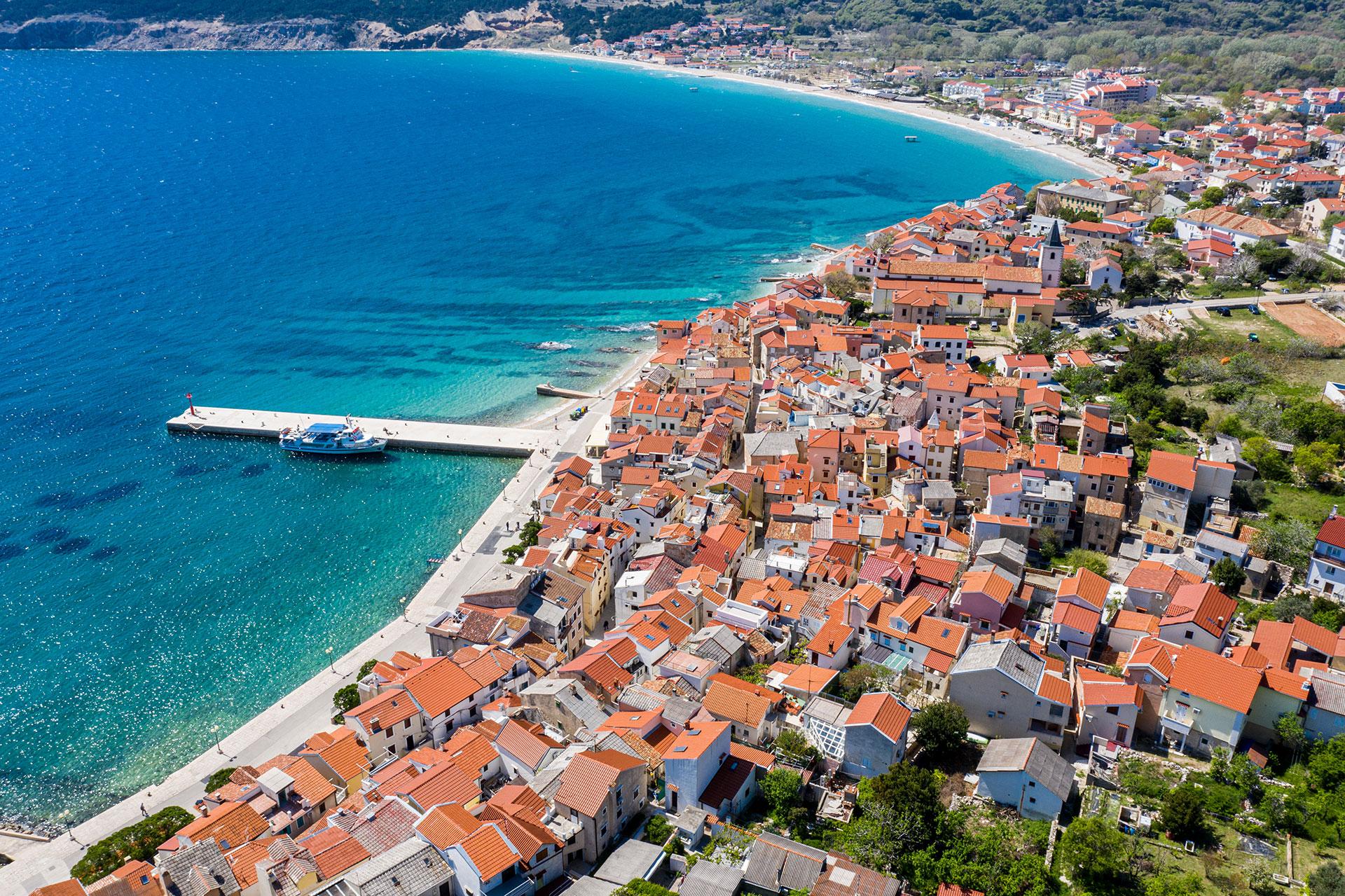
Image: Krk Island Tourist Board
Vrbnik
Vrbnik is indisputably one of the most famous settlements not only on the island of Krk but in all of Croatia. Vrbnik is well known for its Glagolitic heritage and especially for its delicious wines, and in particular is its golden-yellow wine – the Žlahtina, with a great national and international reputation. It's not the only old town on the island of Krk that sits on top of a hill, but Vrbnik sits on a large cliff by the sea, giving it a wonderful view into the distance. Learn more about Vrbnik HERE.
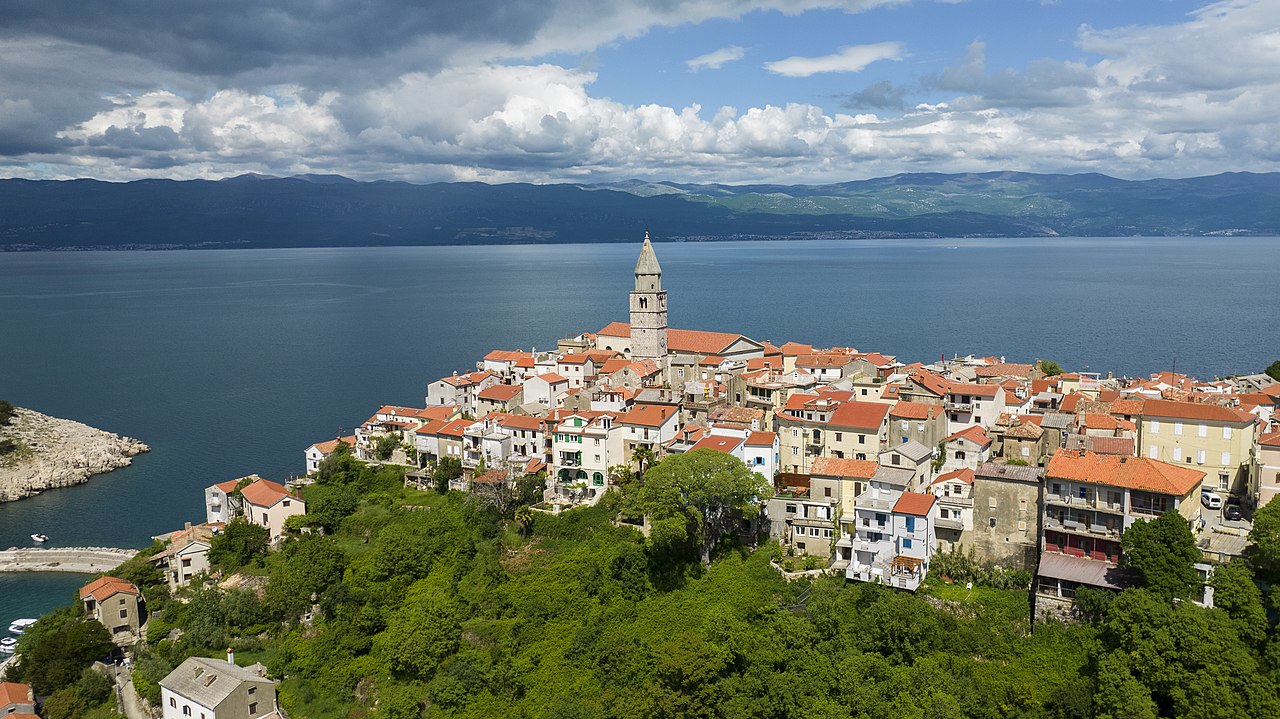
Image: Arne Müseler/Wikimedia Commons
Dobrinj
Dobrinj is located in the upper part of the island of Krk, to the east. Dobrinj includes other places of interest such as Šilo or Klimno, but surely the first thing one should do is visit the main town, which stands on a 200-meter-high hill. Dobrinj is very reminiscent of the settlements one can find in central Istria, also on hills. A beautiful destination without a doubt, surrounded by thick forests and with a great Glagolitic heritage. Likewise, many other important traditions stand out, such as its folkloric events, its typical costumes, its school of wind instruments, and its home cuisine. Learn more about Dobrinj HERE.

Image: Arne Müseler/Wikimedia Commons
For more on travel in Croatia, follow TCN's dedicated page.


